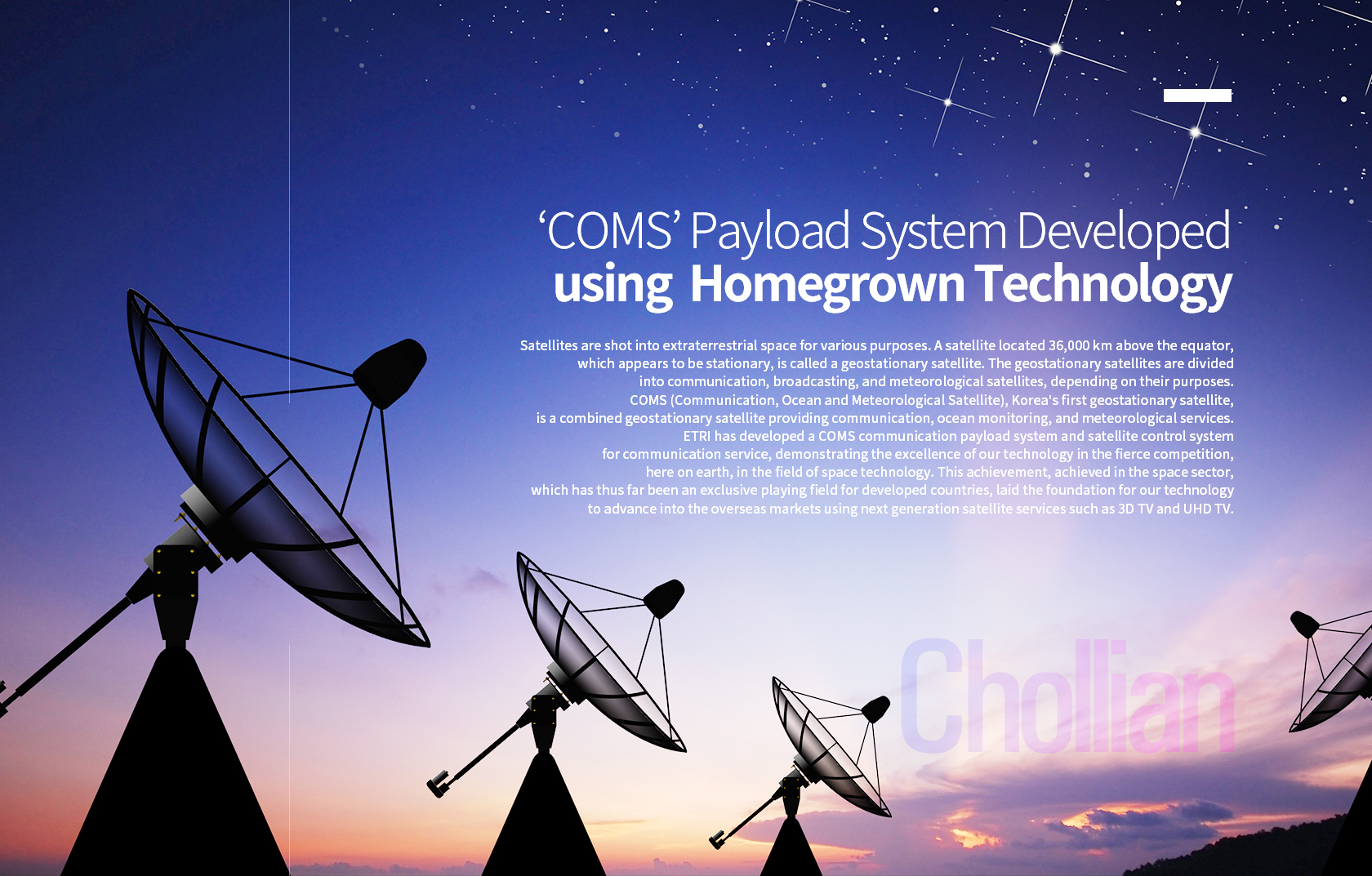
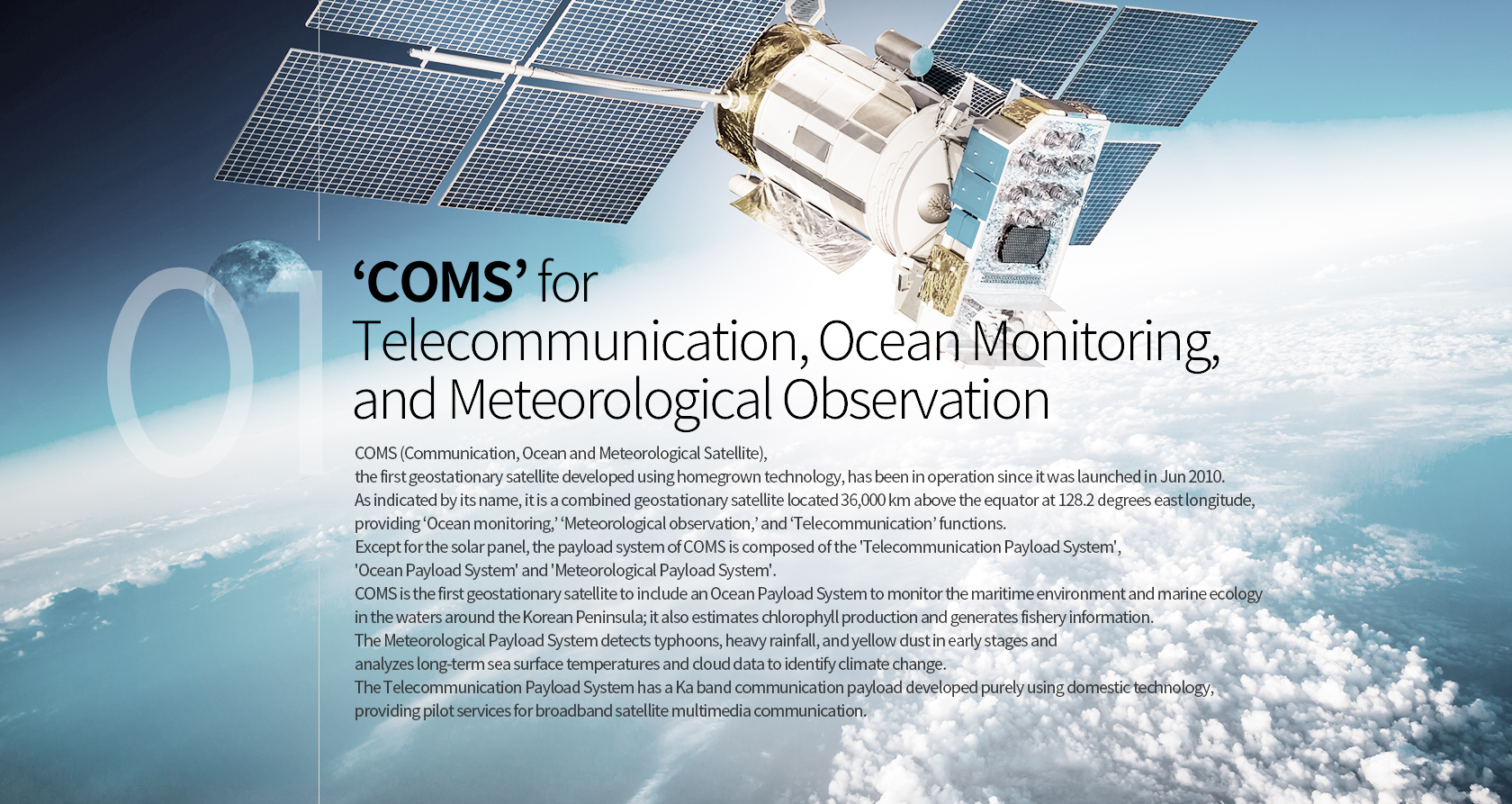
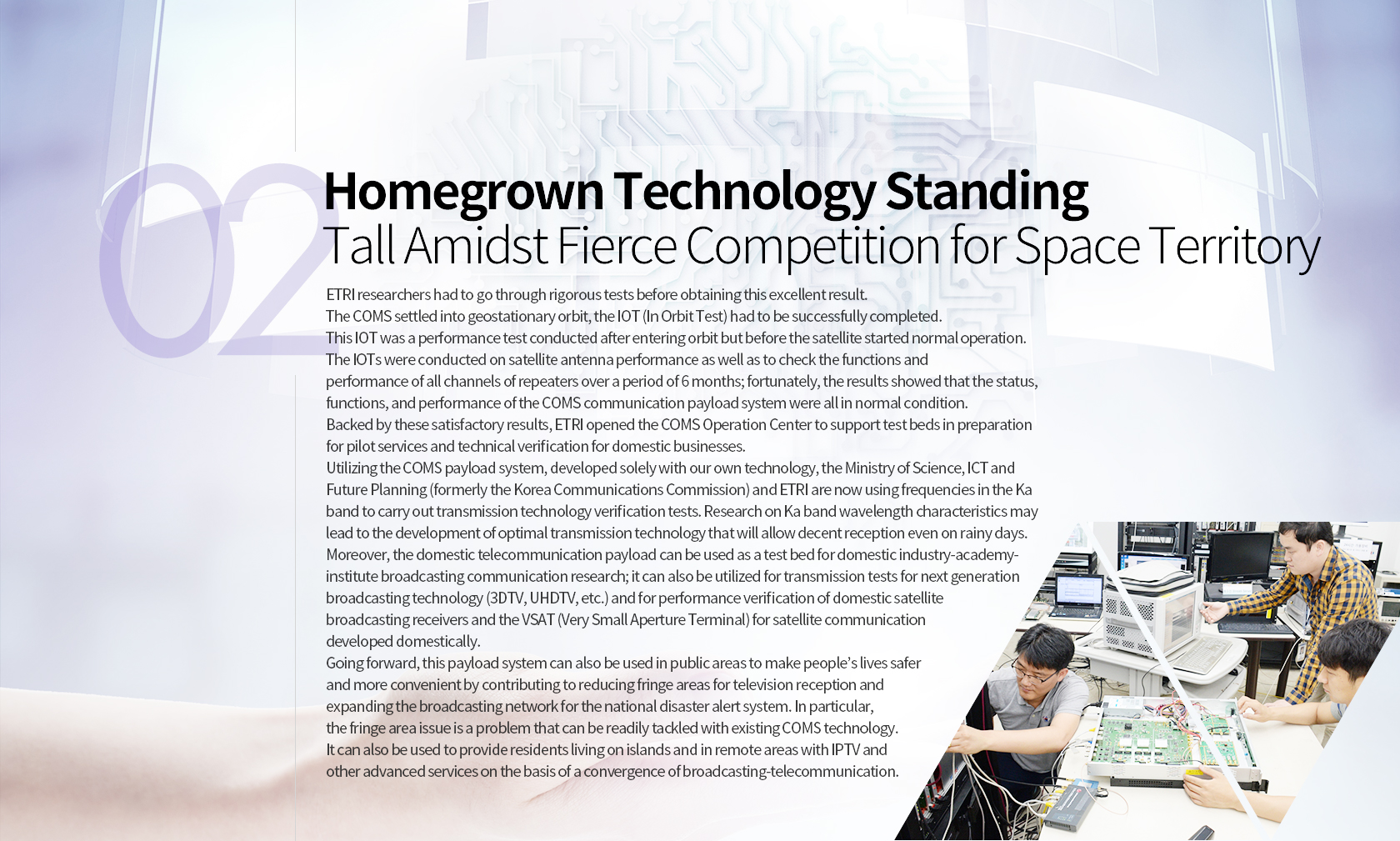
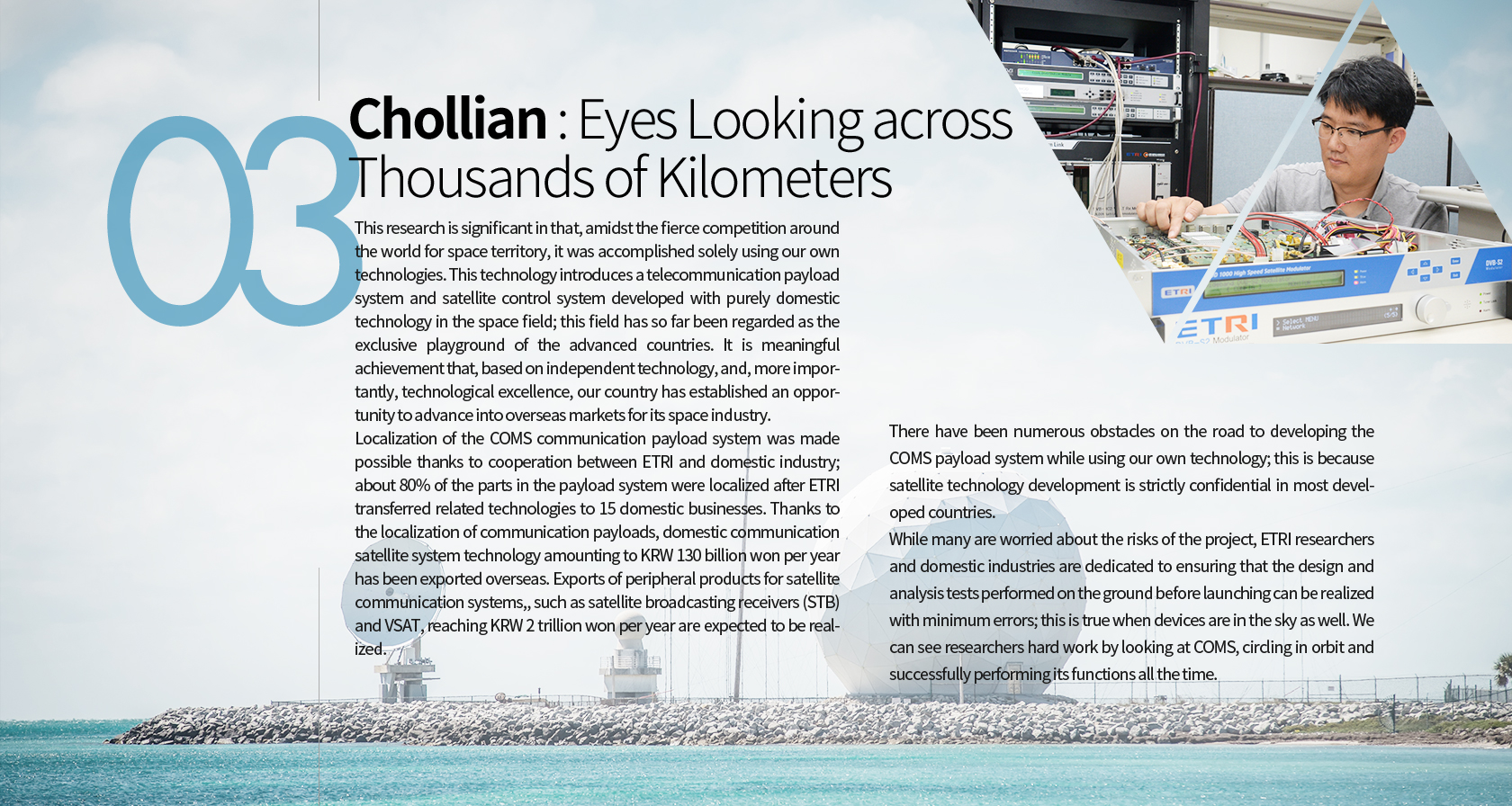
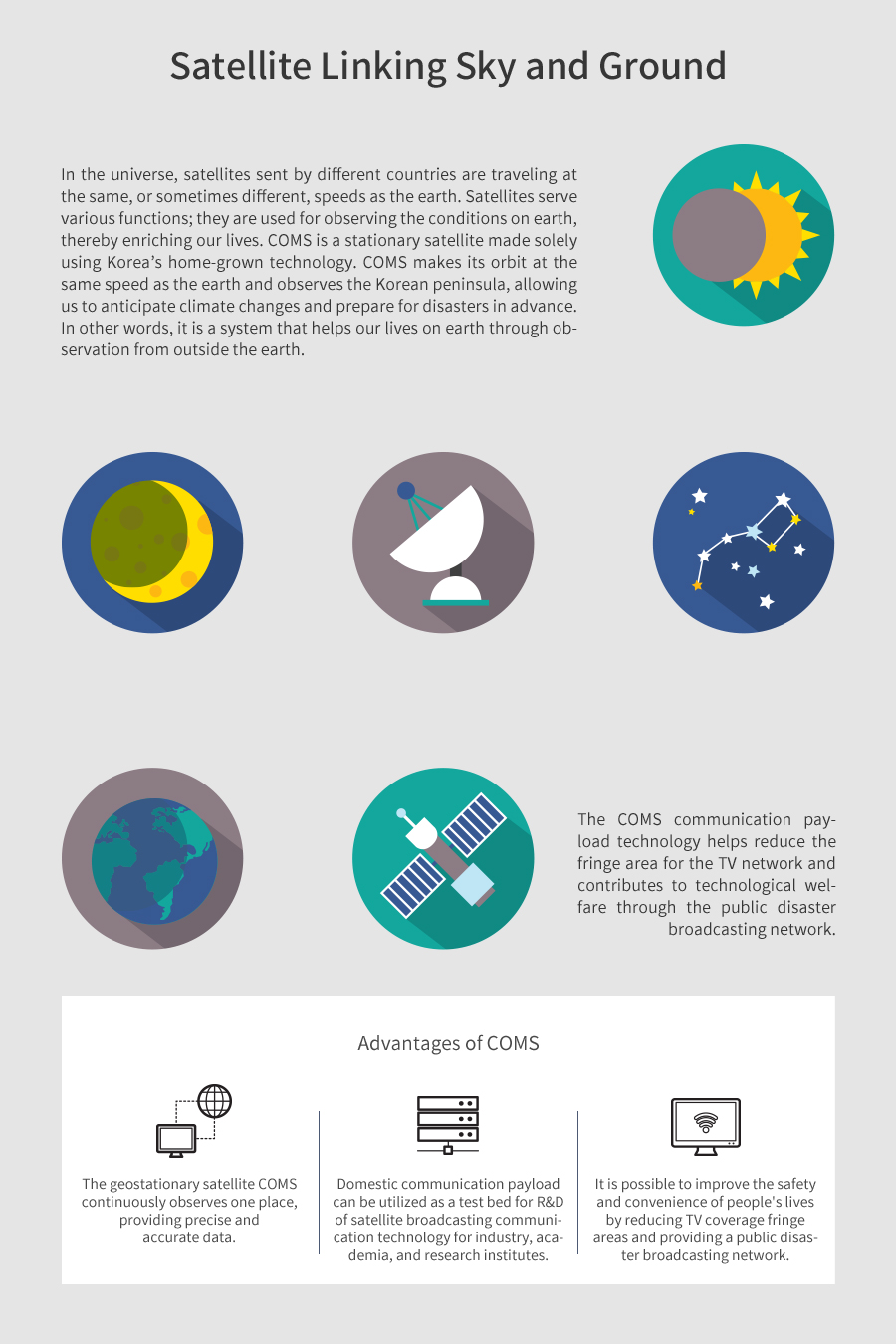
‘COMS’ Payload System Developed
using Homegrown Technology
Satellites are shot into extraterrestrial space for various purposes. A satellite located 36,000 km above the equator, which appears to be stationary, is called a geostationary satellite. The geostationary satellites are divided into communication, broadcasting, and meteorological satellites, depending on their purposes. COMS (Communication, Ocean and Meteorological Satellite), Korea's first geostationary satellite, is a combined geostationary satellite providing communication, ocean monitoring, and meteorological services.
ETRI has developed a COMS communication payload system and satellite control system for communication service, demonstrating the excellence of our technology in the fierce competition, here on earth, in the field of space technology. This achievement, achieved in the space sector, which has thus far been an exclusive playing field for developed countries, laid the foundation for our technology to advance into the overseas markets using next generation satellite services such as 3D TV and UHD TV.

COMS (Communication, Ocean and Meteorological Satellite), the first geostationary satellite developed using homegrown technology, has been in operation since it was launched in Jun 2010. As indicated by its name, it is a combined geostationary satellite located 36,000 km above the equator at 128.2 degrees east longitude, providing ‘Ocean monitoring,’ ‘Meteorological observation,’ and ‘Telecommunication’ functions.
Except for the solar panel, the payload system of COMS is composed of the 'Telecommunication Payload System', 'Ocean Payload System' and 'Meteorological Payload System'. COMS is the first geostationary satellite to include an Ocean Payload System to monitor the maritime environment and marine ecology in the waters around the Korean Peninsula; it also estimates chlorophyll production and generates fishery information. The Meteorological Payload System detects typhoons, heavy rainfall, and yellow dust in early stages and analyzes long-term sea surface temperatures and cloud data to identify climate change. The Telecommunication Payload System has a Ka band communication payload developed purely using domestic technology, providing pilot services for broadband satellite multimedia communication.

ETRI researchers had to go through rigorous tests before obtaining this excellent result. the COMS settled into geostationary orbit, the IOT (In Orbit Test) had to be successfully completed. This IOT was a performance test conducted after entering orbit but before the satellite started normal operation. The IOTs were conducted on satellite antenna performance as well as to check the functions and performance of all channels of repeaters over a period of 6 months; fortunately, the results showed that the status, functions, and performance of the COMS communication payload system were all in normal condition.
Backed by these satisfactory results, ETRI opened the COMS Operation Center to support test beds in preparation for pilot services and technical verification for domestic businesses. Utilizing the COMS payload system, developed solely with our own technology, the Ministry of Science, ICT and Future Planning (formerly the Korea Communications Commission) and ETRI are now using frequencies in the Ka band to carry out transmission technology verification tests. Research on Ka band wavelength characteristics may lead to the development of optimal transmission technology that will allow decent reception even on rainy days. Moreover, the domestic telecommunication payload can be used as a test bed for domestic industry-academy-institute broadcasting communication research; it can also be utilized for transmission tests for next generation broadcasting technology (3DTV, UHDTV, etc.) and for performance verification of domestic satellite broadcasting receivers and the VSAT (Very Small Aperture Terminal) for satellite communication developed domestically.
Going forward, this payload system can also be used in public areas to make people’s lives safer and more convenient by contributing to reducing fringe areas for television reception and expanding the broadcasting network for the national disaster alert system. In particular, the fringe area issue is a problem that can be readily tackled with existing COMS technology. It can also be used to provide residents living on islands and in remote areas with IPTV and other advanced services on the basis of a convergence of broadcasting-telecommunication.

This research is significant in that, amidst the fierce competition around the world for space territory, it was accomplished solely using our own technologies. This technology introduces a telecommunication payload system and satellite control system developed with purely domestic technology in the space field; this field has so far been regarded as the exclusive playground of the advanced countries. It is meaningful achievement that, based on independent technology, and, more importantly, technological excellence, our country has established an opportunity to advance into overseas markets for its space industry.
Localization of the COMS communication payload system was made possible thanks to cooperation between ETRI and domestic industry; about 80% of the parts in the payload system were localized after ETRI transferred related technologies to 15 domestic businesses. Thanks to the localization of communication payloads, domestic communication satellite system technology amounting to KRW 130 billion won per year has been exported overseas. Exports of peripheral products for satellite communication systems,, such as satellite broadcasting receivers (STB) and VSAT, reaching KRW 2 trillion won per year are expected to be realized.
There have been numerous obstacles on the road to developing the COMS payload system while using our own technology; this is because satellite technology development is strictly confidential in most developed countries.
While many are worried about the risks of the project, ETRI researchers and domestic industries are dedicated to ensuring that the design and analysis tests performed on the ground before launching can be realized with minimum errors; this is true when devices are in the sky as well. We can see researchers hard work by looking at COMS, circling in orbit and successfully performing its functions all the time.









